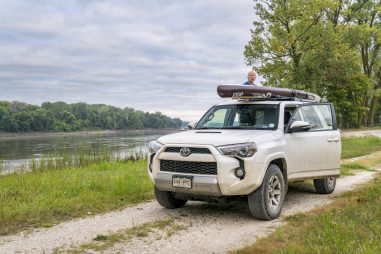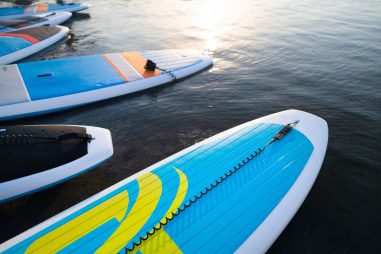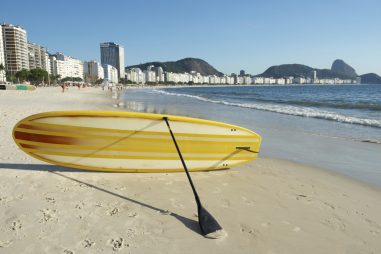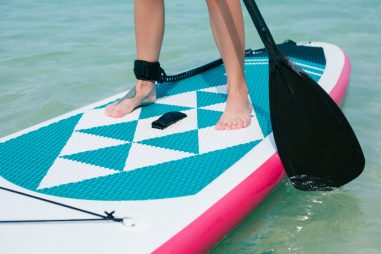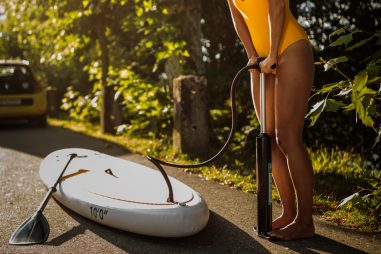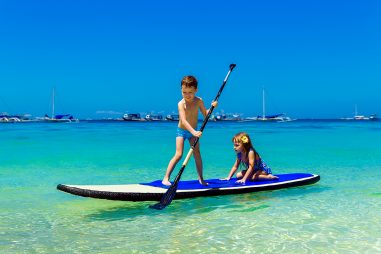Paddle boarding is becoming one of the most popular water sports in the world for many reasons. For one, you don’t need much to start on the sport as you would only need your paddle board, paddle, fins, and leash as the most basic starter pack. And you can also paddle board in almost all bodies of water which makes it highly doable regardless of your age and skill level.
Can You Use a Paddle Board in the Ocean?
You can definitely enjoy paddle boarding in the ocean. However, you may want to skip out on this adventure if you are a paddle boarding beginner. Paddle boarding in the ocean takes a lot more skills than just finding your balance on the board. You have to know how to ride along the waves, how to move across it and how to control your board.
You also have to note that most paddle boards used in the ocean are those made of epoxy or fiberglass or a combination of the two. These are called hardboards or solid boards. Some hardboards are also made with carbon fiber and wood. Hardboards are better as compared to inflatable paddle boards because they are rigid enough to handle the ocean.
Is It Hard to Paddle Board in the Ocean?
It can be pretty hard to paddle board in the ocean as there are more elements to consider than paddle boarding in, say, calmer waters. You might have a harder time staying on the board due to the wind and the waves, so you must have the skills to control your board even when challenged by these elements.
But that is not to say that paddle boarding in the ocean isn’t fun. On the contrary, once you get into the groove of paddle boarding in the ocean, it can be a lot of fun. It is also another opportunity to learn new riding styles like stand up paddle board surfing.
Are Inflatable Paddle Boards Good for the Ocean?
It is not really recommended to use inflatable paddle boards if you want to go paddle boarding in the ocean. Technically, you can use your board in the ocean. However, you have to be sure that the water will stay calm all throughout your stay. Otherwise, you will have a hard time gliding across the water because big waves will sure knock you off your board.
Solid boards or hardboards are more appropriate for paddle boarding in the ocean. These boards are usually made with one or any combination of epoxy, fiberglass, carbon fiber, and wood. This type of board is better to use because they are far more rigid than inflatable paddle boards. These boards will also help you in navigating through the harsh elements and the wind and water conditions.
How Do You Paddle Board in the Ocean?
Now that you know that you can paddle board in the ocean and what board to use, you might be wondering how you actually can paddle board in the ocean. There are some important points that you need to take note of, such as how to enter the water and how to ride the board.
So how do you enter the water, you ask? Here are some key points to note.
- Before you enter the water, be sure to scan the area for a safe spot. A spot is considered safe if there are zero or fewer people around, like swimmers or fellow paddle boarders. This spot is where you will go to enter the water.
- Before hitting the water, make sure that you are safe by wearing a personal flotation device or PFD and a rescue whistle. For the PFD, you can choose between a life jacket or an inflatable belt pack.
- Do not forget to attach your leash. The leash is an important part of your whole paddle boarding ensemble because this will make sure that you are attached to your board at all times, even when you get knocked off by the waves. It ensures that you will not 1) lose your board and 2) hit and injure another person.
- Now that you know where your entry point is and you are wearing your PFD, whistle, and leash, you may enter the water. Carry your board under your arm while it is lying on its side. Make sure that you are not carrying the board parallel to the shore. You can only place your board belly side down when you are waist deep in the water.
Now that you are in the water, how do you actually paddle board across the waves?
- You have to quickly get past the breaking waves. You can do this by either 1) paddling out on your knees and 2) paddling while lying on your stomach on your paddle board.
- The trick is to paddle past the surf zone. Once you are outside this zone, you will be greeted with peaceful swells that you can actually ride.
- Slowly stand upright on your board, look ahead, and paddle as usual.
How Do You Paddle Board in Deep Water?
Before you set out into deeper water, you have to know the basic skills of riding a paddle board. If you are a beginner, you may want to skip this out and just stay in shallow water, where you can control your board better. Now, for you daredevils who want to try paddle boarding in deep water, here are some things that you should know.
- Awareness is key. Be aware of your surroundings, including other people, watercraft, and, most importantly, the conditions of the water and the wind.
- You have to be able to confidently mount your board even when there is a chance that a strong current may wipe you out.
- If you get knocked off by a wave or if you ever lose your balance and you know you are about to fall on the water, be sure to push the board away from your body. This will ensure that there will be no painful contact between you and the board as you fall in the water.
- When you fall into the water, you have to make sure to look for the paddle board then find the paddle. This is why it is important to attach your leash, as it will keep you from losing your board.
- It is more important to get ahold of your board. Once you are back up, you can easily look for your paddle.
How Do You Get Back on a Paddle Board in Deep Water?
There are two ways on how you can get back on the board depending on which side you are going to mount the paddle board on. The first option is to get back up from the side. To do this, you have to grip the carry handle and use it to haul your body over into the board.
The other way is by mounting the paddle board by the tail, which is actually the easier way. To do this, you can easily put your weight on the tail end of the board. After, you can just allow the board to slide onto your chest until you are on top of the board.
Can You Paddle Board in Waves?
You can definitely paddle board in waves. This riding style is also called paddle board surfing, wherein you use your paddle board and your paddle instead of traditional surfing, where you just, well, use your surfboard.
Surfing using your paddle board is a kind of advanced skill that needs time and practice. It is not advisable for a beginner to attempt surfing on their first day of lessons.
How Do You Paddle Board With Waves?
Catching waves on your paddle board is not easy. You have to be able to pick the right day with the right wind, water, and weather conditions, and you have to choose the right spot. With that being said, how do you actually catch a wave with your paddle board?
- First, you have to secure the “out back” position. The “out back” is actually not a specific place in the ocean, but you can spot it by feel. The “out back” is your spot in the ocean away from the breaking waves and a little outside of the set waves of the big group of waves.
- Once you have secured your “out back” position and you spot a wave that you can ride, paddle on your board using your hands, and as you approach then start lifting your body using your arms. To know that you have done this position correctly, the top of the wave has to pass between your body and the board.
- Now onto catching that wave. Once you spot your wave, assume a staggered stance, the body position where you place one foot at the center of the board and the other towards the back. To easily picture it, a staggered stance is much like a hybrid of a parallel stance on your paddle board and a surf stance on your surfboard.
- You have to paddle hard and fast enough to be able to travel at the same speed as the wave.
- Once the wave reaches you and you are riding on top of the wave, keep your knees bent. Make sure that your weight is positioned at the nose of the board.
How Do You Paddle Board Against Current?
If you want to paddle the board while going against the current, you can’t stand upright. Instead, keep your back bent. You should also position your hand down the shaft of your paddle. Use quick and shorter strokes to be able to ride safely against the current.
Paddle boarding in big waves is hard, but let’s be honest, paddle boarding against the current is something else. Doing this takes a lot more stamina, power, and speed as you paddle, and you need some serious skills. You also can’t just go against the current using any board. It has to be the right size for your body dimensions, and only use epoxy (aka solid aka hardboard) paddle boards.
Can You Paddle Board at Low Tide?
You can choose to paddle board at low tide; however, this is not recommended for first time paddle boarders. You see, low tide creates large waves that are pretty hard to handle, especially if you are just starting out.
While these tides can easily bring your back to the shore, they do take a lot more skill to maneuver. If not handled correctly, you just might fall into the water.
Is It Best to Paddle Board at High or Low Tide?
Choosing the best between high and low tides is pretty subjective. Sometimes it boils down to the paddle boarder, and other times it depends on the place. Low tides create large waves that may be hard to ride. On the other hand, high tide can hide big rocks and other large harmful elements in the water that may cause you injury while paddle boarding.
Both tide conditions affect how you ride your paddle board. Paddle boarding on either high or low tired takes more skills than paddling in calm waters.
What Tide Is Best for Paddle Boarding?
The best tide for paddle boarding is said to be the slack tide. Slack tides occur two hours after the occurrence of either high or low tides. Slack tides are said to be the best tide to ride with on a paddle board because the movement of the waves is minimal.
As such, paddle boarding in this wave is not only great for experienced paddle boarders, but beginners can enjoy them too.
How Do You Paddle Board on a Lake?
Lakes are another ideal location to paddle board for beginners. They have calmer waters which help you in finding your balance better. You can use any type of paddle board when going on a lake due to its calm and flat water. However, you still need to pay attention to the weather conditions since strong winds can create tides.
But how do you actually paddle board on a lake? Read on to find out.
- As with any watersport, you have to be aware of your surroundings and make sure that you are wearing all the safety gear like a personal flotation device, whistle, and leash.
- Entering the water is so much easier on a lake because it’s less likely that there will be waves to flip your board over, but you do have to spot a safe entry zone.
- You can mount your paddle board as usual. You can start by kneeling on the board and slowly lifting your body up until you are standing.
- Find your balance.
- When you are balanced correctly, and you are standing upright, you can now slowly move your paddle. Keep your eyes looking ahead.
Can You Use a Paddle Board on a River?
You can definitely enjoy paddle boarding on a river. However, this activity is much more challenging as compared to when you paddle board on a lake where the water is flat. The water conditions in rivers differ, so you may experience a fast current, or they can be flat and calm.
You can use any type of paddle board when you go paddle boarding on a river, but inflatable paddle boards are usually the go-to. This is because inflatable paddle boards are thick enough to endure all the harsh elements of the rivers. Aside from that, inflatable paddle boards are stable enough to conquer even the whitewater of a river.
Do You Need a River License for a Paddle Board?
The river license requirement for your paddle board highly depends on your location, as some places do require you to secure one while other places do not. Some rivers have paddle boarding associations in which you have to acquire membership to be able to paddle board in the area.
If you are not sure if you need to secure a river license for your paddle boarding activities in your locality, it is always best to check with the authorities to ensure that you won’t be breaking any laws.
Can You Paddle Board on Canals?
You can definitely paddle board on canals, and it’s actually another ideal place for beginners to start learning the sport. But you do have to know beforehand if the canal in your vicinity requires you to secure a waterway license. In some places, you don’t need a license, but you do need to ask for permission from local authorities.
You do have to keep watch on the dangers of paddle boarding canals. For one, boaters can pose serious risks for paddle boarders. Make sure to never paddle behind a boat, as the wake can knock you off your paddle board.
Can You Paddle Board in a Pool?
You can totally paddle board in a pool if other large bodies of water are too far from you. However, there are a few things to remember. The pool has to be big enough that you can practice paddling from point A to point B. If you are also in a public pool, you may have to ask if paddle boards are allowed to be used in the pool.
For your safety, remember to wear a helmet. Pools have concrete edges and floors, which can easily injure you if you are not careful.
Where Is the Best Place to Paddle Board?
It is really hard to pick just one best place to paddle board when we have a multitude of paddle boarding meccas all over the world. Here are some of the places that you should visit if you want to fully enjoy paddle boarding.
- Hawaii
- Santa Barbara California
- Islands of the Caribbean
- Key West
- Lake Tahoe
- Banff, Alberta
- Thailand
- Bali, Indonesia
- Perth, Australia
- Palawan, Philippines


